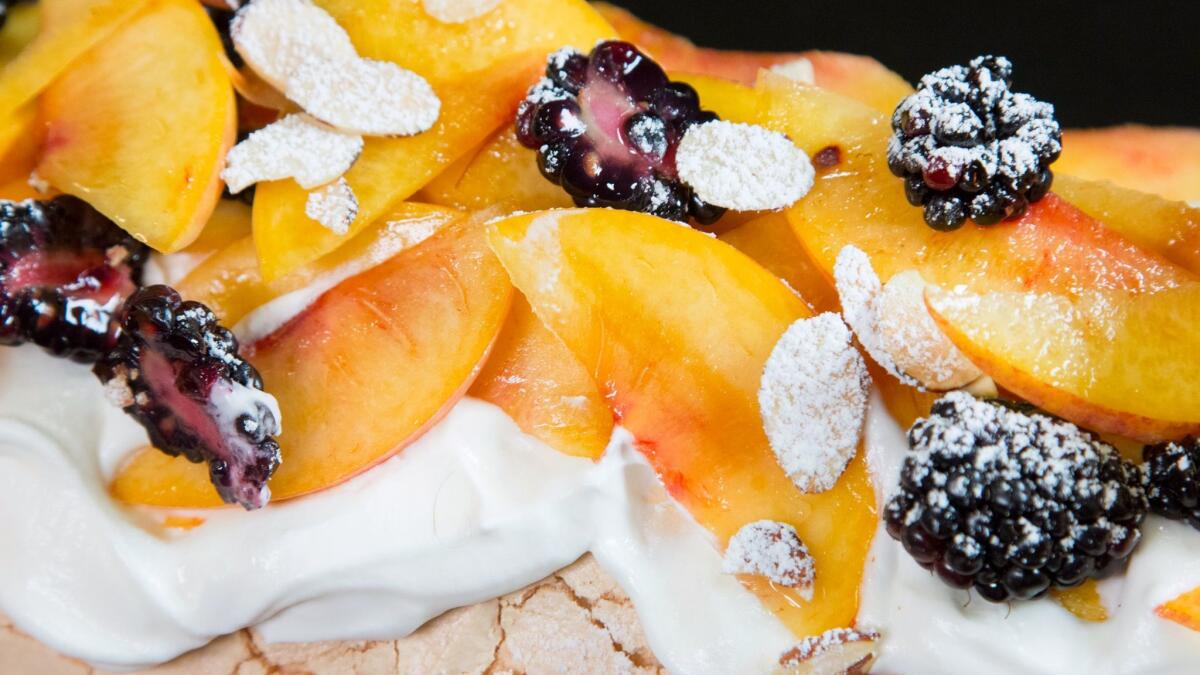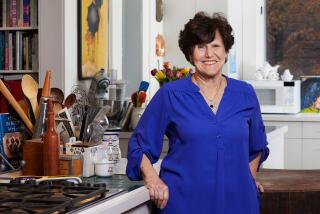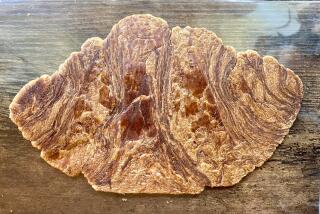Yotam Ottolenghi shares tips for how to make the perfect pavlova

Yotam Ottolenghi and Helen Goh show how to assemble a pavlova, one of the many desserts in their new cookbook, “Sweet.”
For all of the sugar artistry, the showiness of elaborate frosting and gorgeous fruit, on display in a pastry kitchen, desserts are mostly about fundamentals. Basic techniques. Basic ingredients. So it shouldn’t really come as a surprise that egg whites feature so prominently in the latest cookbook from British Israeli chef Yotam Ottolenghi. He began his career as a pastry chef, after all, as did Helen Goh, his collaborator on “Sweet,” their new dessert cookbook. There’s a pavlova on the cover of the American edition. There are about 10 recipes for meringues inside the book. If you’ve ever been to Ottolenghi’s shop in the Notting Hill neighborhood of London, meringues are the first thing you see, towering in the window, confronting you as you walk in the door, begging to be eaten as soon as possible.
And when Ottolenghi and Goh visited The Times’ Test Kitchen, not too long ago, it was a meringue that they demonstrated, in the form of a pavlova tricked out and rolled up like a yule log.
“Meringues are the basis of so many classical desserts; they’re so instrumental in baking,” Ottolenghi said above the loud engine of the KitchenAid mixer. “When you want to show off, you do meringues.” Most often, a pavlova is made as a giant meringue, a Frisbee-sized, free-form confection that’s baked, then topped with whipped cream and fruit or whatever’s on hand. Ottolenghi and Goh have spread out their meringue on a sheet pan and baked it like a sponge cake, then dropped whipped cream, sliced peaches, blackberries and almonds on top and rolled it up, jelly roll style. The result is showstopping.
Although “Sweet” is Ottolenghi’s sixth cookbook, it is his first devoted solely to desserts, and you get the feeling as he talks about it that the book’s making was as much a fun, sugar-high playtime as it was a study in dessert technique. In the kitchen, the two chefs, who each have two children under the age of 7, act like kids themselves, finishing each other’s sentences and jokes as they assemble the parts of the dish.
“Take a deep breath and roll,” instructed Goh, after she and Ottolenghi had loaded the layer of meringue with spoonfuls of cream, fruit and nuts.“If it goes wrong,” pointed out Ottoenghi as he ate the rest of the peaches, “you can always turn it into a trifle.”

Recipe: Rolled pavlova with peaches and blackberries >>
“Sweet” took about three years to write but, said Ottolenghi, he and Goh — the longtime Ottolenghi product developer — have been “talking cakes for 10 years.”
Roughly half of the recipes are from the Ottolenghi restaurants — there are five in London — and half were developed for the book. “We wanted to make it really user-friendly,” said Goh, “not just special-occasion.” So although there are a few stunners — a lemon and blackcurrant stripe cake, say, with towering vertical pink and yellow layers — there’s an emphasis on family-friendly treats and not a few cookie recipes for which, as Ottolenghi put it, “you don’t need a lot of kit.”
Those of us whose kitchen shelves are lined with Ottolenghi’s previous cookbooks (among them “Plenty,” “Jerusalem” and “Plenty More”) will note a few marked differences from that stack and this book. Most obviously, the chef who often seems to be credited with reinventing Middle Eastern cuisine (“I can credit myself with making it a little bit more sexy”) has written a book that isn’t particularly regional. Yes, there’s the rosewater and the pistachios, and there is halvah in the brownies, but “Sweet” reads like a fairly traditional European — even British — dessert book. There are recipes for celebration cake, for sticky fig pudding, for Victoria sponge cake, even a recipe for fruitcake.
The difference is also in the methodology. “The subject matter is so different,” Ottolenghi said about “Sweet.” “It’s about the technique; savory is more about the ingredients.”
And if you’re wondering about the next cookbook: yes, it’s already in the works. “The next one is going to be Ottlenghi simple,” the chef said, after he and Goh sliced — and sampled — their pavlova. It’ll be “more functional, about how food functions on a daily basis. I look at the recipes and they’re so short.”
Meanwhile, if you like your dessert recipes short, maybe try the Cats’ Tongues, delicate biscuits that take all of three steps to make; or the lime posset, a cream-based pudding that takes just two steps, plus adding some papaya and lime. If, however, your idea of fun is beating giant bowls of egg whites — Ottolenghi’s first kitchen job was doing just that — there is recipe after recipe for that, for sponge cakes and Powder Puffs, as well as that remarkable stripe cake. And yes, for meringues, whether you roll them up or display them prettily near your kitchen window.
More to Read
Eat your way across L.A.
Get our weekly Tasting Notes newsletter for reviews, news and more.
You may occasionally receive promotional content from the Los Angeles Times.







